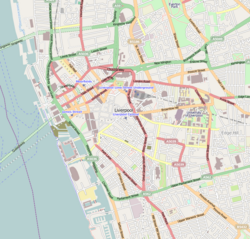History
The street was one of the original seven streets that made up the medieval borough founded by King John in 1207, together with Water Street, Old Hall Street, Chapel Street, High Street, Tithebarn Street and Dale Street. [2]
Of the original seven streets, Castle Street was one of the most important due to it running from the river to the castle and the market. [3] Its course was marked out at the creation of the Borough by a representative of King John. The boundary of the market was marked out by three Sanctuary Stones, one of which still remains on Castle Street. [4]
The original street was very narrow, with barely enough room for two carts to pass each other. [3] During the 18th and 19th centuries the road was widened.
Whilst once home to several banks, Castle Street is now home to many restaurants and bars and considered part of Liverpool's Food Quarter. [5] [6]
This page is based on this
Wikipedia article Text is available under the
CC BY-SA 4.0 license; additional terms may apply.
Images, videos and audio are available under their respective licenses.

